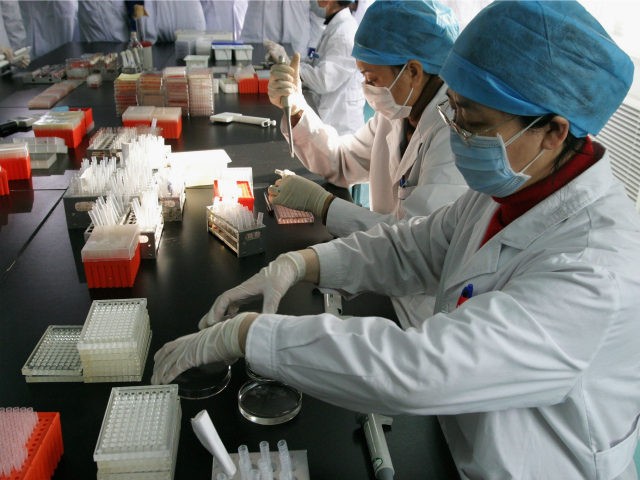As a new coronavirus outbreak in China rapidly spirals from a handful of asymptomatic cases in one city district to a regional crisis, the governor of Hebei province accused a medical agency of falsifying test results and demanded a re-screening.
China’s state-run Global Times claimed Monday that only three positive coronavirus tests were hidden, but the governor of Hebei operated as if he suspected the problem was much worse than that, and the high degree of interest from Chinese Internet users suggests a good deal of apprehension from the general public, as well:
Jinan Huaxi Medical Laboratory, which was hired to process COVID-19 [Chinese coronavirus] tests in Longyao, reported on Thursday to the local health commission that it had finished the analysis of some 310,000 swab samples taken from the county’s residents, which had all returned negative results, when in fact it had not even completed the testing.
Two days later, the company made a different claim, saying that a set of samples had tested positive. The county immediately carried out an investigation, which found two confirmed cases and one asymptomatic case on Sunday, while exposing the lab’s false reporting of the samples that it had received. Police detained the person in charge of the company.
In response to the incident, Xu Qin, governor of Hebei, ordered a thorough reexamination of all the nucleic acid tests carried out by agencies, stressing that “no one should be left out, and all data be authentic,” China News reported on Monday.
Chinese officials blamed testing problems on the private companies hired to conduct the coronavirus screenings and called for closer government oversight of the process. The Jinan Huaxi Medical Laboratory in particular was faulted for a history of questionable behavior, including the failure to properly dispose of medical waste in the early days of the coronavirus outbreak.
Outside observers, and more than a few exasperated Chinese citizens, are frustrated at the constant shifting of blame from supposedly infallible government officials to private companies. An Associated Press (AP) investigation in December blamed the dangerous shortage of testing and treatment in Wuhan during the first months of the outbreak on “secrecy and cronyism at China’s top disease control agency” and deliberate steps taken by the Chinese Communist Party (CCP) to keep the dangers of Chinese coronavirus secret from both Chinese citizens and the outside world.
The CCP party line blames the companies contracted for early testing much more than the corrupt officials who gave them the contracts, even though insiders told the AP officials at China’s Center for Disease Control were essentially bribed to give those valuable contracts to three Shanghai-based companies.
Chinese health officials simultaneously blocked independent doctors and laboratories from testing for the coronavirus, because they wished to conceal the extent of the epidemic. The result sounds similar to what is happening in Hebei province today:
These measures contributed to not a single new case being reported by Chinese authorities between Jan. 5 and 17, even though retrospective infection data shows that hundreds were infected. The apparent lull in cases meant officials were slow to take early actions such as warning the public, barring large gatherings and curbing travel. One study estimates that intervention two weeks earlier could have reduced the number of cases by 86 percent, although it’s uncertain whether earlier action could have halted the spread of the virus worldwide.
When tests from the three companies arrived, many didn’t work properly, turning out inconclusive results or false negatives. And technicians were hesitant to use test kits that would later prove more accurate from more established companies, because the CDC did not endorse them.
With few and faulty kits, only one in 19 infected people in Wuhan was tested and found positive as of Jan. 31, according to an estimate by Imperial College London. Others without tests or with false negatives were sent back home, where they could spread the virus.
The outbreak in Hebei and its capital city of Shijiazhuang has grown serious enough for a 3,000-unit coronavirus hospital to be rushed into construction, similar to the treatment centers that were rapidly built around Wuhan in the spring of 2020. Shijiazhuang and several other cities in Hebei are currently under lockdown and quarantine orders as China’s Lunar New Year holiday travel season approaches.
A team from the World Health Organization (W.H.O.) has arrived in China after several last-minute delays and is currently under mandatory quarantine before beginning its investigation of the Chinese coronavirus’s origins. The United States and Australia on Monday called on China to allow the team to directly interview “caregivers, former patients, and lab workers” and examine samples taken from Wuhan, instead of allowing Chinese personnel to conduct the first phase of the investigation.
The Independent Panel for Pandemic Preparedness and Response issued a report on Monday that said its evaluation of “the chronology of the early phase of the outbreak suggests that there was potential for early signs to have been acted on more rapidly.”
The report said it was “clear” that “public health measures could have been applied more forcefully by local and national health authorities in China in January.”
The panel also asserted that W.H.O. should have declared a Public Health Emergency of International Concern over the Wuhan coronavirus outbreak sooner, and said it was “not clear” why W.H.O. waited as long as it did.

COMMENTS
Please let us know if you're having issues with commenting.